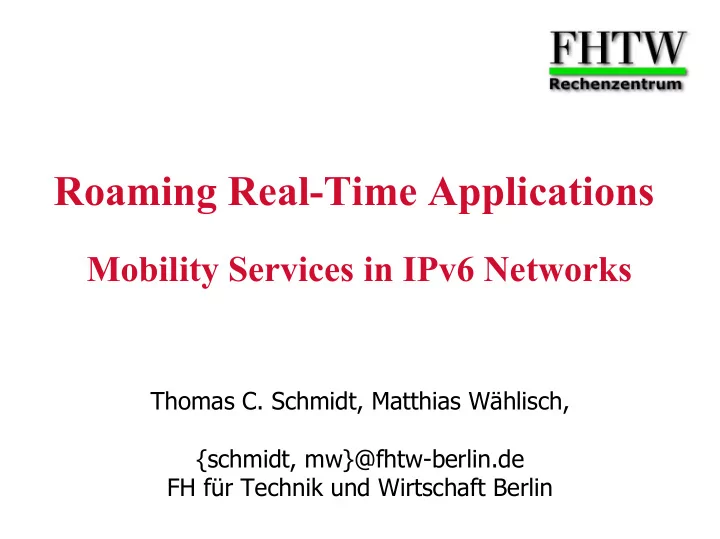

Roaming Real-Time Applications Mobility Services in IPv6 Networks Thomas C. Schmidt, Matthias Wählisch, {schmidt, mw}@fhtw-berlin.de FH für Technik und Wirtschaft Berlin
VCoIP in Praxis
VCoIP in Praxis
VCoIP in Praxis
VCoIP in Praxis
Agenda � VCoIP & Real-Time Communication � Internet Mobility � Local MIPv6 Handover � Improving the General Handover � Mobile Multicasting � Conclusions & Outlook
VCoIP Real-Time Requirements ! Latency ≈< 100 ms ! Jitter ≈< 50 ms ! Packet loss ≈< 1 % ! Interruption: 100 ms ≈ 1 spoken syllable ! Typically: Multicast Listener & Sender
The daViCo Videoconferencing System
daViCo Videoconferencing Software Pure Software solution including • multicast/multipoint video communication • highly efficient wavelet video codec • buffer latencies about 100 ms • application sharing • implements peer-to-peer model • implements IPv6 and user location • designed for best effort transport & effortless use
IP Mobility Approaches o Mobile IPv6 - Stateless, transport transparent handover o Multicast-based IP Mobility Support - Mobile with personal multicast address o Mobile SCTP - Stateful transport handover (doubly bound) o SIP Handover - SIP-server as application specific home agent
Mobile IPv6
Local Handover Performance Experimental Scenario • Focus on local handoff over 802.11b • MN: Linux MIPL 0.9.4 (DAD removed) • Rtr: FreeBSD 4.6 + rtadvd, MinDelayBetweenRAs = 50 ms • UDP-Probe: Triggered (10 – 20 ms) reflection of numbered and time stamped packets • Sniffer event recording (etherreal)
Empirical Results
Improvement: L2-Trigger Reduce - MAX_RA_DELAY_TIME ≈ 1 – 3 ms - MAX_RTR_SOLICITATION_DELAY ≈ 1 – 3 ms
Empirical Results Implementation Noise HA: Linux Debian 2.4.19; MIPL Mobile IPv6 0.9.4 CN,MN: Windows 2000, SP2; MSR (1.4) TCP-IPv6 driver, 5.0.21955.1620 Router: FreeBSD 4.6-STABLE: rtadvd
Accelerating MIPv6 in a General Topology Generally HA and CN are at Significant Distance o Handover Time: = + + t t t t − − − − handoff local BU of HA BU of CN { } ≈ + 3 + t t t local CN HA 2 o Jitter Enhancement: Jitter + t t handoff ≈ HA CN Jitter t stationary CN Essential: Eliminate HA/CN RTT Dependence
Proxy: Hierarchical MIPv6 t CN t , Binding Updates with HA and CN preserve dependence! HA
Fast MIPv6 Handover Attempt to hide handover procedure by • Anticipation of Handover from Layer 2 • Directing traffic to new location (Layer 3!) Problems: • Layer 2 : Layer 3 topology map needed • Handover moment not reliably predictable
Conclusions & ‘Fast HMIP’ Proposal Conclusions: → Local proxy agent needed → Handover hiding needed, as well Proposal for handover hiding: → Use previously established communication path → Send and receive via prev. MAP (until BU finished) → CN needs to preserve last Binding Cache entries t CN t , Resolves dependency, covers rapid movement HA
Packet Processing: Tunneling Jitter and Delay rely on packet processing Problems caused by tunneling approach – extra overhead – fragmentation at tunnel entry – QoS parameters lost by encapsulation Avoid tunneling by ⇒ Forward & readdress at MAP (mobility ext. hds.) ⇒ Rebuild or tunnel only other packets at MAP
Mobile Multicasting o Bi-directional multicast capabilities needed o Problem: asymmetric, slow convergence - up to ≈ 30 s at listener - up to ≈ 3 min at sender - no information on mcast tree completion o Use: multicast is stateless and unreliable o Use: unicast mobility infrastructure
Mobile Multicast Listener Proposal Mobile multicast listener anchored at MAP: • Submits MLD Listener Report through (new) MAP • Sends BU to previous MAP on handover (forwarding) • BU with 0 Lifetime to previous MAP on MLD LR completion MAP anchoring mobile multicast listeners • Record subscribed group addresses in binding caches • Answer MLD queries/sustain mcast tree membership • Forward multicast packets to the mobile nodes (as unicasts)
Mobile Multicast Source Proposal Mobile multicast source anchored at MAP: • Use Home Address Option (CN must not verify BC on mcast) • Send mcast packets exactly as unicast (through MAP) • On handover continue sending via previous MAP • On handover start sending via new MAP • Stop sending via previous MAP on timeout • On rapid Movement: stay with established MAP
HMIP Multicast Source
HMIP Multicast Source MAP-Local Handover
HMIP Multicast Source Inter-MAP Handover (1)
HMIP Multicast Source Inter-MAP Handover (2)
Conclusions & Outlook √ MIPv6 can be made suitable for real-time communication. √ Needs proxying and handover hiding. √ Mobile Multicast approach presented. Future Development: • Further analysis & simulation of proposed schemes • Optimization & refinement
VCoIP in Praxis
VCoIP in Praxis Thank Thank You ! You !
Recommend
More recommend